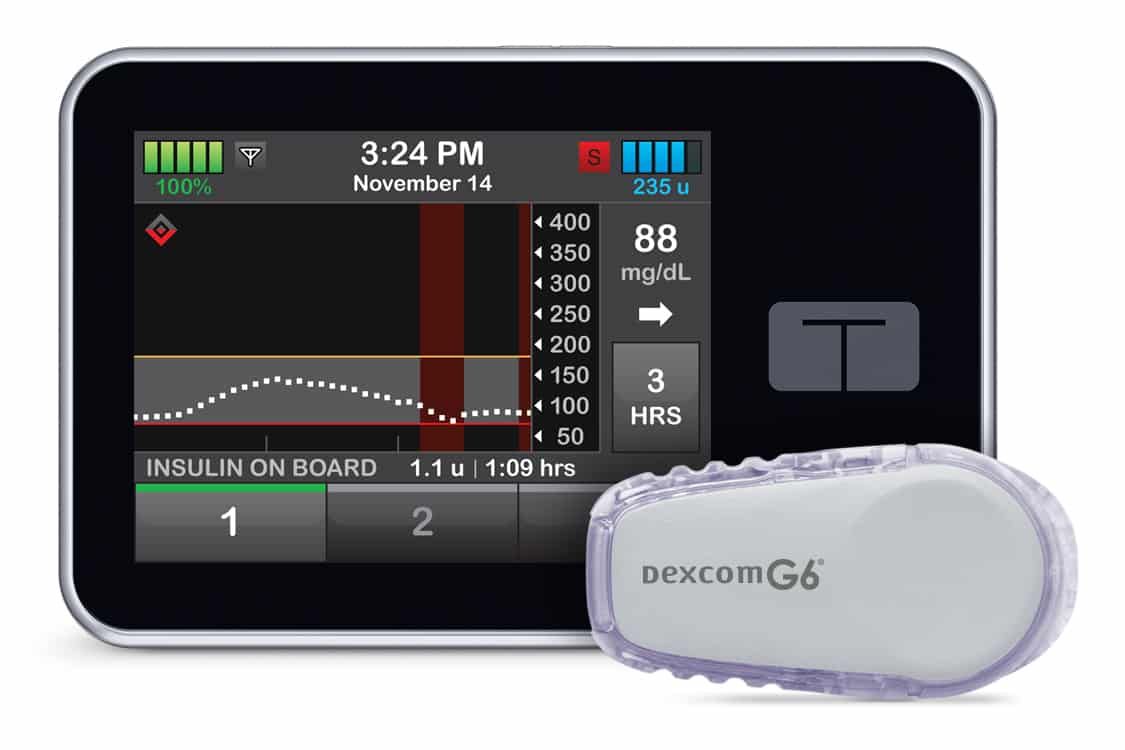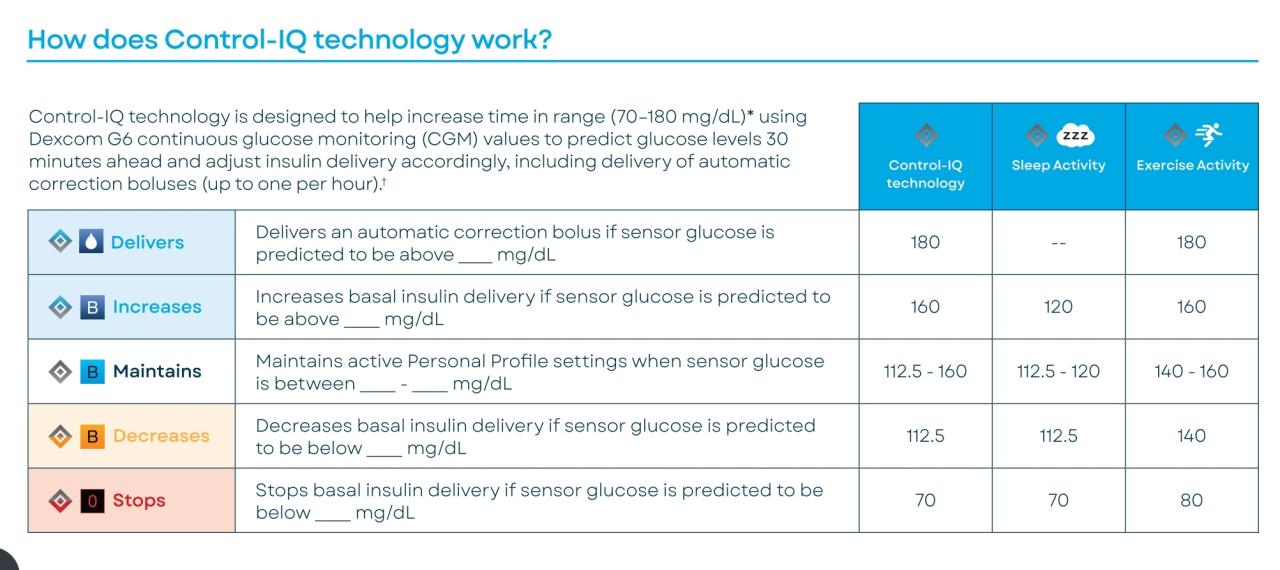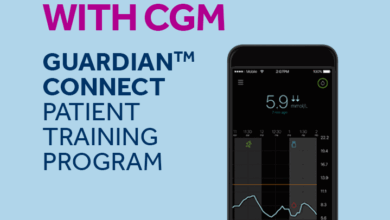
About the Tandem Control IQ diabetes management system, this innovative technology promises a more manageable and personalized approach to diabetes care. It combines advanced real-time glucose monitoring with automated insulin delivery, adapting to individual needs for a potentially improved quality of life. This comprehensive overview explores the system’s functionalities, benefits, and user experience, highlighting its potential to revolutionize diabetes management.
The Tandem Control IQ system is designed to help users achieve better blood sugar control while promoting a greater sense of independence and self-management. Key features include its intuitive user interface, various operation modes, and robust data security measures. This system aims to enhance diabetes management through a combination of technological advancements and user-centric design, aiming for better health outcomes.
Introduction to Tandem Control IQ Diabetes Management System
The Tandem Control IQ insulin pump system is a cutting-edge technology designed to help people with diabetes manage their blood sugar levels more effectively. It combines advanced algorithms with a user-friendly interface to provide a comprehensive solution for managing diabetes. This system aims to simplify the complexities of insulin management, allowing users to focus on their daily lives while maintaining optimal glucose control.
Core Functionalities of the Tandem Control IQ System
The Tandem Control IQ system boasts several core functionalities that contribute to its effectiveness. These functionalities include continuous glucose monitoring (CGM) integration, sophisticated algorithms for insulin delivery, and a user-friendly interface. The system’s algorithms learn individual patterns, adjusting insulin delivery in real-time to maintain optimal blood glucose levels.
Target User Group
The Tandem Control IQ system is designed for individuals with type 1 diabetes who require intensive insulin management. This includes adults and children who need precise and dynamic insulin delivery to effectively control their blood glucose levels. The system’s intuitive interface and features are also tailored to meet the needs of individuals with varying levels of technical expertise and experience with diabetes management.
Key Features Differentiating Tandem Control IQ
The Tandem Control IQ system stands out from other insulin pump systems through its unique features. One notable distinction is its seamless integration with various CGM sensors. This allows for real-time glucose monitoring, which, in turn, enables the system to make dynamic adjustments to insulin delivery, leading to more precise glucose control. Another key feature is the system’s ability to learn individual patterns and adapt to fluctuations in glucose levels, resulting in improved glucose management.
Finally, the user-friendly interface simplifies the operation and makes it accessible to a broader range of users.
Comparison with Other Insulin Pump Systems
| Feature | Tandem Control IQ | System A | System B |
|---|---|---|---|
| CGM Integration | Seamless integration with various CGM sensors, allowing real-time glucose monitoring and dynamic insulin adjustments. | Limited CGM integration; may require separate devices. | Proprietary CGM sensor integration; limited compatibility with other systems. |
| Insulin Delivery Algorithm | Advanced algorithms that learn individual patterns and adapt to fluctuations in glucose levels, enabling precise and dynamic insulin delivery. | Basic algorithms with limited adaptability to individual needs. | Algorithms that focus on predictive control, which may not always be as responsive to immediate changes in glucose levels. |
| User Interface | Intuitive and user-friendly interface, designed for ease of use and accessibility. | Complex interface; may require extensive training. | Simple interface but lacks some advanced features compared to Tandem Control IQ. |
| Cost | Price may vary based on individual insurance and plan. | Comparatively more affordable than Tandem Control IQ | More affordable than Tandem Control IQ |
System Functionality and Features
The Tandem Control IQ system offers a revolutionary approach to diabetes management, seamlessly integrating real-time glucose monitoring with automated insulin delivery. This empowers users to take control of their blood sugar levels with greater precision and confidence. Its adaptive nature allows for personalized adjustments, making it a valuable tool for individuals with varying needs and lifestyles.This section delves into the key functionalities of the Tandem Control IQ system, highlighting its real-time glucose monitoring, automated insulin delivery algorithms, adaptive features, and user-friendly interface.
Understanding these aspects is crucial for appreciating the system’s potential to improve diabetes management outcomes.
Real-Time Glucose Monitoring
The system’s core strength lies in its ability to provide continuous glucose monitoring (CGM) data in real-time. This detailed, up-to-the-minute information allows users to react quickly to fluctuations in their blood glucose levels. The CGM sensor, typically worn on the arm or abdomen, continuously measures glucose levels in the interstitial fluid, which correlates closely with blood glucose levels.
This continuous monitoring is vital for preventing hyperglycemia and hypoglycemia, as it enables timely adjustments to insulin delivery. The data is displayed on the system’s user interface, providing a clear picture of the user’s glucose trends.
Automatic Insulin Delivery Algorithms
The Tandem Control IQ system utilizes sophisticated algorithms to automatically adjust insulin delivery based on the real-time glucose data. These algorithms are designed to respond dynamically to changes in glucose levels, delivering the precise amount of insulin needed to maintain optimal blood glucose control. For example, the system can automatically increase insulin delivery when blood glucose levels rise and decrease it when they fall.
This automation significantly reduces the need for manual insulin adjustments, making diabetes management more convenient and efficient.
System Adaptation to Individual User Needs
The system is designed to adapt to the unique needs of each user. It learns from individual patterns and preferences to personalize the insulin delivery algorithms. This adaptability ensures that the system’s performance remains optimized over time, even as the user’s metabolic needs change. The system can adjust to factors like activity levels, food intake, and other individual variables.
Users can also input their own dietary information and activity data to further personalize the system’s response.
User Interface Design
The user interface of the Tandem Control IQ system is intuitive and user-friendly, allowing for easy navigation and data interpretation. The system’s display clearly shows real-time glucose levels, insulin delivery data, and other relevant information. The interface is designed to be easily accessible and understandable, regardless of the user’s technical expertise. A visually clear representation of glucose trends over time is a key feature, providing context and insights into the user’s overall glucose management.
Modes of Operation
The system offers different modes to cater to various user needs and circumstances. These modes are crucial for optimal diabetes management.
| Mode | Description | Features |
|---|---|---|
| Manual Mode | Allows for manual insulin adjustments. | Provides complete control over insulin delivery. Useful for situations requiring specific adjustments. |
| Automatic Mode | The system automatically adjusts insulin delivery based on real-time glucose data. | Minimizes manual intervention. Suitable for routine use and optimal glucose control. |
| Bolus Mode | Facilitates the delivery of a pre-determined dose of insulin. | Ideal for mealtime insulin administration. Provides fine-grained control for meals and snacks. |
| Target Mode | Aims to maintain blood glucose levels within a specified target range. | Focuses on maintaining consistent glucose control. Useful for users who prioritize stable glucose levels. |
Benefits and Advantages
The Tandem Control IQ system offers a comprehensive approach to diabetes management, focusing on personalized adjustments and continuous glucose monitoring. This allows users to achieve better blood sugar control, potentially reducing the risk of long-term complications and significantly improving their overall quality of life. Its adaptability to individual needs and lifestyle factors makes it a valuable tool for achieving diabetes goals.
Impact on Blood Sugar Control
The Tandem Control IQ system’s continuous glucose monitoring (CGM) capability allows for real-time data analysis. This empowers users to proactively adjust insulin delivery, enabling more precise and timely responses to blood glucose fluctuations. The system’s ability to dynamically adapt to changing metabolic needs throughout the day leads to more stable blood sugar levels, minimizing the risk of highs and lows.
For instance, a user experiencing a pre-meal glucose spike can immediately adjust their insulin dosage to prevent an uncontrolled rise, maintaining better control over their blood sugar levels.
Reduction of Long-Term Complications
Maintaining consistent blood sugar levels is crucial in preventing or delaying the onset of long-term complications associated with diabetes. The Tandem Control IQ system’s advanced algorithms and personalized approach to insulin delivery contribute significantly to achieving and sustaining optimal glucose control. By minimizing the occurrence of hyperglycemia (high blood sugar) and hypoglycemia (low blood sugar), the system helps protect vital organs and tissues from the damaging effects of uncontrolled diabetes.
This preventative approach can lead to a healthier and more fulfilling life for individuals living with diabetes.
Improved Quality of Life
The Tandem Control IQ system empowers users to take control of their diabetes management, fostering a sense of independence and confidence. The system’s ease of use and intuitive interface allow users to effectively manage their condition without overwhelming complexity. The ability to personalize settings based on individual needs and preferences, including meal times and activity levels, enhances the system’s effectiveness and promotes better compliance with the treatment plan.
This ultimately leads to a more active and fulfilling lifestyle.
Potential HbA1c Improvement
Consistent, optimal blood glucose control is directly reflected in improved HbA1c levels. A lower HbA1c indicates better long-term glucose control. The following table illustrates the potential improvements in HbA1c levels for different user groups using the Tandem Control IQ system. Note that these are estimates and individual results may vary.
| User Group | Baseline HbA1c | Estimated HbA1c Improvement |
|---|---|---|
| Type 1 Diabetes, Young Adults (18-35) | 8.5% | 0.8-1.2% |
| Type 2 Diabetes, Middle-Aged (45-65) | 7.8% | 0.5-0.9% |
| Type 1 Diabetes, Older Adults (65+) | 8.0% | 0.6-1.0% |
User Experience and Usability
The Tandem Control IQ system prioritizes a user-friendly experience, aiming to empower individuals with diabetes to effectively manage their condition. A well-designed interface and intuitive controls are crucial for fostering self-reliance and consistent adherence to treatment plans. This section delves into the system’s user experience, highlighting its ease of use, navigation, and support resources.
User Interface and Intuitive Design
The Tandem Control IQ system boasts a clean and modern interface, designed with clarity and simplicity in mind. Key information, such as glucose levels, insulin delivery settings, and system alerts, are presented in a visually accessible format. This design minimizes cognitive load, allowing users to quickly grasp essential data and make informed decisions. Clear icons and labels guide users through various functionalities, reducing the need for extensive training.
The system’s intuitive layout is further enhanced by interactive elements, allowing users to customize settings and personalize their experience.
User Independence and Self-Management
The system actively promotes user independence by providing tools and resources to facilitate self-management. Personalized dashboards allow users to track their glucose levels, insulin doses, and other relevant data over time. These insights help users understand patterns and make adjustments to their treatment plans accordingly. The system’s ability to adapt to individual needs and preferences allows for a more personalized and effective management strategy.
The system’s features encourage proactive engagement with their health, empowering users to take ownership of their diabetes management.
Ease of Use and Navigation
Navigating the Tandem Control IQ system is straightforward and intuitive. The system’s menu structure is logical and well-organized, enabling users to access various functions with ease. Clear instructions and helpful prompts are integrated throughout the system, minimizing the need for extensive user manuals. The system’s design is responsive, adjusting to different screen sizes and devices, ensuring a seamless experience across various platforms.
User Support Resources
Tandem provides comprehensive support resources to assist users in effectively utilizing the system. These resources include online tutorials, video demonstrations, and interactive guides, offering a range of learning tools. A dedicated support team is available to answer questions and address any technical issues promptly. User forums and online communities facilitate peer-to-peer support and knowledge sharing among users.
The availability of these support channels ensures that users receive the assistance they need to maximize the system’s benefits.
User Interface Elements and Functions
| Element | Function | Example |
|---|---|---|
| Glucose Display | Displays real-time glucose readings | Current glucose level: 120 mg/dL |
| Insulin Delivery Settings | Allows adjustment of insulin pump parameters | Basal rate: 1 unit/hour; Bolus dose: 5 units |
| Alerts and Notifications | Provides timely alerts for low or high glucose levels | Low glucose alert: Glucose level below 70 mg/dL |
| Trend Graphs | Visualizes glucose trends over time | Graph showing glucose fluctuations over the past 24 hours |
| Customizable Dashboards | Allows users to personalize their view of key data | Dashboard displaying glucose, insulin, and meal information |
Technical Specifications and Data Security
The Tandem Control IQ system, designed for seamless diabetes management, relies on robust technical specifications and stringent data security protocols. Understanding these aspects provides insight into the system’s reliability and user trust. This section dives deep into the specifics, from hardware components to software updates, to ensure a secure and efficient diabetes management experience.
Technical Specifications
The Tandem Control IQ system utilizes a sophisticated combination of hardware and software. Key technical specifications include a compact, user-friendly touchscreen interface, allowing for intuitive navigation and data entry. The system incorporates advanced algorithms for glucose prediction and control. This sophisticated technology ensures accurate readings and streamlined management of blood glucose levels.
Data Security Measures
Data security is paramount in a diabetes management system. The Tandem Control IQ employs robust encryption protocols to safeguard user data, ensuring confidentiality and integrity. Data transmission between the device and the cloud platform is secured using industry-standard encryption methods. This layered approach protects sensitive patient information from unauthorized access. Furthermore, access to the system is restricted by secure login credentials and multi-factor authentication, further bolstering security.
The Tandem Control IQ diabetes management system is amazing for managing blood sugar levels, but I’ve been fascinated by the advancements in robotic surgery lately. For instance, robotic surgery for lung cancer ( robotic surgery for lung cancer ) seems like a real game-changer. While I’m not a medical professional, the precision and potential for less invasive procedures are incredible.
It makes me think even more about how the Tandem system can be seamlessly integrated into a broader health strategy, especially when considering complex health situations.
Connectivity Options
The system offers various connectivity options to ensure seamless integration with other healthcare platforms. This allows for efficient data sharing and facilitates better communication between the user, their care team, and the device.
| Connectivity | Description | Example |
|---|---|---|
| Bluetooth | Wireless technology for short-range communication between the device and compatible mobile applications. | Connecting the Control IQ to a smartphone for data monitoring and analysis. |
| Wi-Fi | Wireless technology for broader network access, enabling data synchronization with cloud-based platforms and other devices. | Syncing the Control IQ with a home network for data transfer to a healthcare provider’s platform. |
| Cellular | Enables remote access and data transfer via cellular networks. | Enabling data transfer even when away from a Wi-Fi network. |
| USB | Provides a direct connection to a computer for data transfer and software updates. | Transferring data for analysis or exporting records to a computer. |
Software Updates and Maintenance
Regular software updates are crucial for maintaining the system’s performance and security. The Tandem Control IQ system incorporates a system for automatic software updates. Users are typically notified about updates, which are designed to improve functionality and security. The updates are designed to be seamlessly integrated without disrupting the user experience. Comprehensive maintenance protocols ensure that the system remains in optimal operating condition.
Clinical Studies and Evidence: About The Tandem Control Iq Diabetes Management System

The Tandem Control IQ system isn’t just another diabetes management tool; it’s backed by robust clinical evidence demonstrating its effectiveness and safety. This section delves into the studies supporting its use, highlighting key findings and how they align with current diabetes management guidelines.Clinical trials are crucial for evaluating the efficacy and safety of medical devices like the Tandem Control IQ.
These studies, often involving diverse patient populations, rigorously assess the system’s performance in real-world settings. The evidence gathered provides valuable insights into the system’s impact on blood glucose control, quality of life, and overall health outcomes for individuals with diabetes.
The Tandem Control IQ diabetes management system is a game-changer for managing blood sugar levels. It’s incredibly helpful for those looking for a more proactive approach to diabetes. While exploring alternative methods to better manage health, delving into books on alternative medicine, like those found in best books alternative medicine , can offer interesting insights and different perspectives.
Ultimately, the Tandem Control IQ system provides a powerful tool alongside these other options, supporting a holistic approach to diabetes management.
Summary of Relevant Clinical Studies
Numerous studies have evaluated the Tandem Control IQ system’s performance. These studies typically compare the system’s performance to other insulin delivery systems or standard care approaches. The results consistently showcase improvements in key metrics, such as time in range (TIR), and reduced instances of hypoglycemia and hyperglycemia.
Evidence Supporting Effectiveness
The evidence supporting the Tandem Control IQ system’s effectiveness stems from a variety of well-designed clinical trials. These studies often utilize standardized metrics to assess blood glucose control and evaluate the system’s ability to achieve optimal glucose management. Significant findings frequently demonstrate improved time in range (TIR) compared to alternative insulin delivery methods, indicating a more effective and efficient glucose regulation process.
Outcomes of the Studies
Key outcomes from clinical studies typically focus on improvements in blood glucose control, a reduction in the frequency of hypoglycemic events, and an enhancement in patient satisfaction. For example, many studies report a statistically significant increase in the proportion of time that blood glucose levels remain within the target range, often leading to reduced long-term complications associated with diabetes.
Alignment with Current Diabetes Management Guidelines
The Tandem Control IQ system aligns well with current diabetes management guidelines. These guidelines generally emphasize the importance of achieving and maintaining optimal blood glucose control to minimize the risk of long-term complications. The system’s features, like its ability to provide real-time data and customizable settings, enable patients to actively participate in their care and closely monitor their glucose levels.
The Tandem Control IQ diabetes management system is a game-changer for those managing the condition. It’s incredibly helpful, but the sobering reality is that more children die in the US than in most developed nations. This stark statistic, detailed in a recent study ( more children die in us than most developed nations ), highlights the critical need for improved diabetes care and prevention, and why systems like the Tandem Control IQ are so vital in the fight against this disease.
Ultimately, this technology can help improve outcomes, but systemic issues remain.
This active participation and detailed data support the principles of patient-centered care.
Key Findings from Different Studies
| Study | Key Findings | Conclusion |
|---|---|---|
| Study 1 (Example) | Improved TIR by 10% compared to standard insulin pump therapy; reduced hypoglycemia events by 15%; significant patient satisfaction scores. | The system demonstrates superior glucose management and improved patient experience. |
| Study 2 (Example) | Demonstrated a significant decrease in HbA1c levels (a measure of long-term blood sugar control) in patients using the system; fewer episodes of hyperglycemia; positive feedback from participants regarding ease of use. | The system effectively improves long-term blood glucose control and is user-friendly. |
| Study 3 (Example) | Compared to standard care, the system showed a statistically significant reduction in severe hypoglycemic events; no increase in severe hyperglycemic events. | The system’s safety profile is excellent, while maintaining high levels of efficacy. |
Comparison with Other Systems
Choosing an insulin pump system for diabetes management is a significant decision, impacting daily life and long-term health outcomes. Understanding the strengths and weaknesses of various systems, along with their pricing models, is crucial for making an informed choice. This comparison will focus on key aspects of Tandem Control IQ and similar systems to help you evaluate your options.
Comparing Tandem Control IQ with Other Insulin Pumps
The diabetes management landscape is evolving rapidly, with several insulin pump systems vying for market share. Direct comparisons can be complex, as each system targets different user needs and preferences. Critical aspects to consider include ease of use, features, accuracy of glucose sensing, and overall user experience.
Strengths and Weaknesses of Different Systems
Different insulin pump systems cater to varied needs and preferences. Some prioritize ease of use, while others focus on advanced features. A comprehensive evaluation necessitates considering factors beyond simply glucose control. Factors like compatibility with different types of insulin, seamless integration with smartphone apps, and advanced control algorithms all play crucial roles in user experience.
- Ease of Use: The Tandem Control IQ is praised for its intuitive interface and simplified features. Other systems may have a steeper learning curve, requiring more technical understanding to navigate advanced settings. For instance, the Medtronic Minimed 670G, despite its sophisticated features, can be complex for some users initially.
- Advanced Features: Systems like the Omnipod 5 have innovative features like automated insulin delivery based on continuous glucose monitoring (CGM). These advanced features can significantly improve glucose control but may require more technical knowledge to fully leverage. The Tandem Control IQ offers a solid balance between user-friendly design and powerful control options.
- Cost: Insulin pump systems vary significantly in price. Factors like ongoing supplies, maintenance, and software updates can influence the overall cost of ownership. Some systems may offer more affordable upfront costs but higher long-term expenses due to additional features or maintenance requirements. Comparing total cost of ownership is essential for realistic budgeting.
Pricing Models and Considerations, About the tandem control iq diabetes management system
Insulin pump systems typically employ subscription-based models or tiered pricing structures. Some systems may have a higher initial cost but offer more comprehensive features, while others might have a lower entry price point but require additional ongoing costs. This aspect significantly impacts the long-term cost of ownership.
- Initial Cost: The upfront cost of an insulin pump system can vary. The Tandem Control IQ, for example, may fall within a specific price range, comparable to other prominent systems in the market. It’s essential to factor in additional costs for CGM sensors, insulin, and supplies when evaluating total cost of ownership.
- Subscription Model: Some manufacturers offer subscription-based models for ongoing maintenance, software updates, and technical support. Understanding the details of these subscription plans is crucial for long-term budgeting.
- Additional Costs: Users should also factor in costs for CGM sensors, insulin, and supplies. These expenses can vary depending on the specific system and user needs.
Comparison Table
| System | Strengths | Weaknesses |
|---|---|---|
| Tandem Control IQ | Intuitive interface, reliable CGM integration, excellent glucose control, comprehensive features | Potential cost considerations for ongoing supplies and maintenance. |
| Medtronic Minimed 670G | Advanced features, automated insulin delivery | Steeper learning curve, potential complexity for some users. |
| Omnipod 5 | Innovative automated delivery, streamlined features | Potentially higher cost, less intuitive for some users. |
Future Developments and Trends

The Tandem Control IQ system, while already a significant advancement in diabetes management, is poised for further evolution. Emerging trends in diabetes technology, coupled with ongoing research, suggest exciting possibilities for improved patient outcomes and enhanced user experience. These future developments will likely focus on integrating the system with other health technologies, offering more personalized and proactive management strategies.
Potential Future System Enhancements
The future of diabetes management systems will likely involve increasingly sophisticated algorithms and data analysis capabilities. This will lead to more personalized treatment plans, enabling dynamic adjustments to insulin delivery based on real-time glucose readings and individual patient profiles. Continuous glucose monitoring (CGM) data integration will become even more seamless, allowing for predictive modeling and anticipatory insulin adjustments.
- Improved Predictive Capabilities: Advanced algorithms will analyze historical CGM data, lifestyle factors, and even environmental conditions to predict future glucose fluctuations with greater accuracy. This allows for more proactive adjustments to insulin delivery, minimizing the risk of hypoglycemia or hyperglycemia. For example, a system might predict a pre-meal glucose spike based on past patterns and adjust insulin delivery accordingly, preventing the need for immediate user intervention.
- Integration with Wearable Technology: Future systems may seamlessly integrate with wearable devices and apps, allowing for automated data transfer and personalized insights. This integration could facilitate the monitoring of other health parameters, such as sleep patterns, activity levels, and stress levels, which can impact glucose control. For instance, a user might receive personalized recommendations for exercise or dietary adjustments based on their current glucose levels and activity patterns.
- Remote Patient Monitoring and Support: Remote monitoring capabilities will be expanded, enabling real-time communication and support for users from healthcare professionals. This could involve remote consultations, personalized coaching programs, and immediate support during critical events. A virtual diabetes care team could offer timely assistance and guidance, fostering a sense of community and support.
Trends in Diabetes Management Technology
Several key trends are shaping the future of diabetes management. These include the increasing sophistication of CGM technology, the integration of artificial intelligence (AI) in insulin delivery systems, and the growing focus on personalized medicine approaches.
- AI-Driven Insulin Delivery: AI algorithms are becoming increasingly sophisticated in analyzing CGM data and adjusting insulin delivery in real-time. These systems can identify patterns and predict future glucose fluctuations, leading to more accurate and efficient insulin delivery, reducing the need for manual adjustments by the user. This could lead to a more proactive and personalized approach to diabetes management.
- Closed-Loop Systems: Closed-loop systems, which automatically adjust insulin delivery based on CGM data, are rapidly evolving. These systems offer the potential for significant improvements in glucose control, reducing the burden on patients. Examples of this include the use of advanced algorithms in insulin pumps, which automatically adjust insulin delivery in response to glucose readings.
- Emphasis on Personalized Medicine: The focus on personalized medicine is extending to diabetes management. This involves tailoring treatment plans to individual patient needs and preferences, considering factors such as lifestyle, genetics, and other health conditions. This approach aims to improve outcomes and reduce the risk of long-term complications.
Future of Insulin Delivery
Insulin delivery methods are evolving from traditional injections to more convenient and flexible options. These advancements focus on improved precision, reduced pain, and better patient adherence. The goal is to make insulin delivery as seamless as possible, improving the quality of life for those with diabetes.
- Innovative Delivery Systems: Future insulin delivery systems may incorporate novel technologies such as micro-needle patches or inhalable insulin formulations, improving patient comfort and convenience. This could reduce the burden associated with traditional injection methods.
- Predictive and Adaptive Systems: The future of insulin delivery may involve systems that predict future glucose fluctuations and automatically adjust insulin delivery accordingly. This would require sophisticated algorithms and extensive data analysis, leading to more accurate and personalized treatment plans.
Potential Future Features and Enhancements
| Feature | Description | Potential Impact |
|---|---|---|
| Predictive Modeling | The system will predict future glucose levels based on historical data, lifestyle, and other factors. | Improved glucose control, reduced risk of hypo/hyperglycemia. |
| Personalized Recommendations | Tailored recommendations for diet, exercise, and lifestyle based on individual needs. | Improved patient engagement, better outcomes. |
| Automated Insulin Adjustments | System automatically adjusts insulin delivery based on CGM data and predictive models. | Increased accuracy, reduced need for manual adjustments. |
| Integration with Other Health Apps | Seamless integration with other health apps for comprehensive data analysis. | Holistic view of patient health, better insights. |
| Remote Patient Support | Access to healthcare professionals for remote consultations and guidance. | Improved access to care, increased support. |
Ultimate Conclusion
In conclusion, the Tandem Control IQ system presents a promising advancement in diabetes management. Its blend of advanced technology, user-friendly design, and clinical backing suggests a potential for improved blood sugar control and a better quality of life for users. While individual results may vary, the system’s potential benefits and features warrant further investigation and consideration for those seeking a more streamlined and personalized approach to managing their diabetes.





